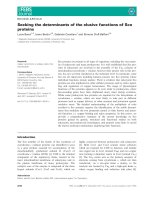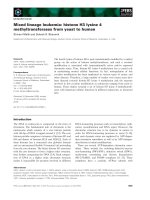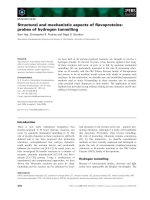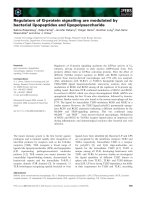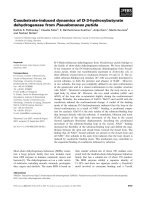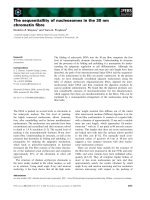Tài liệu Báo cáo khoa học: "k-valued Non-Associative Lambek Categorial Grammars are not Learnable from Strings" pptx
Bạn đang xem bản rút gọn của tài liệu. Xem và tải ngay bản đầy đủ của tài liệu tại đây (119 KB, 8 trang )
k-valued Non-Associative Lambek Categorial Grammars
are not Learnable from Strings
Denis B
´
echet
INRIA, IRISA
Campus Universitaire de Beaulieu
Avenue du G´en´eral Leclerc
35042 Rennes Cedex
France
Annie Foret
Universit´e de Rennes1, IRISA
Campus Universitaire de Beaulieu
Avenue du G´en´eral Leclerc
35042 Rennes Cedex
France
Abstract
This paper is concerned with learning cat-
egorial grammars in Gold’s model. In
contrast to k-valued classical categorial
grammars, k-valued Lambek grammars
are not learnable from strings. This re-
sult was shown for several variants but
the question was left open for the weak-
est one, the non-associative variant NL.
We show that the class of rigid and k-
valued NL grammars is unlearnable from
strings, for each k; this result is obtained
by a specific construction of a limit point
in the considered class, that does not use
product operator.
Another interest of our construction is that
it provides limit points for the whole hier-
archy of Lambek grammars, including the
recent pregroup grammars.
Such a result aims at clarifying the pos-
sible directions for future learning algo-
rithms: it expresses the difficulty of learn-
ing categorial grammars from strings and
the need for an adequate structure on ex-
amples.
1 Introduction
Categorial grammars (Bar-Hillel, 1953) and Lam-
bek grammars (Lambek, 1958; Lambek, 1961) have
been studied in the field of natural language process-
ing. They are well adapted to learning perspectives
since they are completely lexicalized and an actual
way of research is to determine the sub-classes of
such grammars that remain learnable in the sense of
Gold (Gold, 1967).
We recall that learning here consists to define an
algorithm on a finite set of sentences that converge
to obtain a grammar in the class that generates the
examples. Let G be a class of grammars, that we
wish to learn from positive examples. Formally, let
L(G) denote the language associated with grammar
G, and let V be a given alphabet, a learning algorith-
m is a function φ from finite sets of words in V
∗
to
G, such that for all G ∈ G with L(G) =< e
i
>
i∈N
there exists a grammar G
∈ G and there exists n
0
∈
N such that: ∀n > n
0
φ({e
1
, . . . , e
n
}) = G
∈ G
with L(G
) = L(G).
After pessimistic unlearnability results in (Gold,
1967), learnability of non trivial classes has been
proved in (Angluin, 1980) and (Shinohara, 1990).
Recent works from (Kanazawa, 1998) and (Nicolas,
1999) following (Buszkowski and Penn, 1990) have
answered the problem for different sub-classes of
classical categorial grammars (we recall that the w-
hole class of classical categorial grammars is equiv-
alent to context free grammars; the same holds for
the class of Lambek grammars (Pentus, 1993) that is
thus not learnable in Gold’s model).
The extension of such results for Lambek gram-
mars is an interesting challenge that is addressed by
works on logic types from (Dudau-Sofronie et al.,
2001) (these grammars enjoy a direct link with Mon-
tague semantics), learning from structures in (Re-
tor and Bonato, september 2001), complexity results
from (Florˆencio, 2002) or unlearnability results from
(Foret and Le Nir, 2002a; Foret and Le Nir, 2002b);
this result was shown for several variants but the
question was left open for the basic variant, the non-
associative variant NL.
In this paper, we consider the following question:
is the non-associative variant NL of k-valued Lam-
bek grammars learnable from strings; we answer by
constructing a limit point for this class. Our con-
struction is in some sense more complex than those
for the other systems since they do not directly trans-
late as limit point in the more restricted system NL.
The paper is organized as follows. Section 2
gives some background knowledge on three main
aspects: Lambek categorial grammars ; learning in
Gold’s model ; Lambek pregroup grammars that we
use later as models in some proofs. Section 3 then
presents our main result on NL (NL denotes non-
associative Lambek grammars not allowing empty
sequence): after a construction overview, we dis-
cuss some corollaries and then provide the details
of proof. Section 4 concludes.
2 Background
2.1 Categorial Grammars
The reader not familiar with Lambek Calculus and
its non-associative version will find nice presenta-
tion in the first ones written by Lambek (Lambek,
1958; Lambek, 1961) or more recently in (Kandul-
ski, 1988; Aarts and Trautwein, 1995; Buszkowski,
1997; Moortgat, 1997; de Groote, 1999; de Groote
and Lamarche, 2002).
The types T p, or formulas, are generated
from a set of primitive types P r, or atom-
ic formulas by three binary connectives “ / ”
(over), “ \ ” (under) and “•” (product): T p ::=
P r | T p \ Tp | T p / Tp | T p • T p. As a logical sys-
tem, we use a Gentzen-style sequent presentation. A
sequent Γ A is composed of a sequence of for-
mulas Γ which is the antecedent configuration and a
succedent formula A.
Let Σ be a fixed alphabet. A categorial grammar
over Σ is a finite relation G between Σ and T p. If
< c, A >∈ G, we say that G assigns A to c, and we
write G : c → A.
2.1.1 Lambek Derivation
L
The relation
L
is the smallest relation between
T p
+
and T p, such that for all Γ, Γ
∈ Tp
+
, ∆, ∆
∈
T p
∗
and for all A, B, C ∈ T p :
∆, A, ∆
C Γ A
(Cut)
∆, Γ, ∆
C
A A (Id)
Γ A ∆, B, ∆
C
/L
∆, B / A, Γ, ∆
C
Γ, A B
/R
Γ B / A
Γ A ∆, B, ∆
C
\L
∆, Γ, A \ B, ∆
C
A, Γ B
\R
Γ A \ B
∆, A, B, ∆
C
•L
∆, A • B, ∆
C
Γ A Γ
B
•R
Γ, Γ
A • B
We write L
∅
for the Lambek calculus with empty
antecedents (left part of the sequent).
2.1.2 Non-associative Lambek Derivation
NL
In the Gentzen presentation, the derivability rela-
tion of NL holds between a term in S and a formula
in T p, where the term language is S ::= T p|(S, S).
Terms in S are also called G-terms. A sequent is a
pair (Γ, A) ∈ S × T p. The notation Γ[∆] repre-
sents a G-term with a distinguished occurrence of ∆
(with the same position in premise and conclusion
of a rule). The relation
NL
is the smallest relation
between S and T p, such that for all Γ, ∆ ∈ S and
for all A, B, C ∈ Tp :
Γ[A] C ∆ A
(Cut)
Γ[∆] C
A A (Id)
Γ A ∆[B] C
/L
∆[(B / A, Γ)] C
(Γ, A) B
/R
Γ B / A
Γ A ∆[B] C
\L
∆[(Γ, A \ B)] C
(A, Γ) B
\R
Γ A \ B
∆[(A, B)] C
•L
∆[A • B] C
Γ A ∆ B
•R
(Γ, ∆) (A • B)
We write NL
∅
for the non-associative Lambek
calculus with empty antecedents (left part of the se-
quent).
2.1.3 Notes
Cut elimination. We recall that cut rule can be e-
liminated in
L
and
NL
: every derivable sequent
has a cut-free derivation.
Type order. The order ord(A) of a type A of L or
NL is defined by:
ord(A) = 0 if A is a primitive type
ord(C
1
/ C
2
) = max(ord(C
1
), ord(C
2
) + 1)
ord(C
1
\ C
2
) = max(ord(C
1
) + 1, ord(C
2
))
ord(C
1
• C
2
) = max(ord(C
1
), ord(C
2
))
2.1.4 Language.
Let G be a categorial grammar over Σ. G gen-
erates a string c
1
. . . c
n
∈ Σ
+
iff there are types
A
1
, . . . , A
n
∈ T p such that: G : c
i
→ A
i
(1 ≤ i ≤
n) and A
1
, . . . , A
n
L
S. The language of G,
written L
L
(G) is the set of strings generated by G.
We define similarly L
L
∅
(G), L
NL
(G) and L
NL
∅
(G)
replacing
L
by
L
∅
,
NL
and
NL
∅
in the sequent
where the types are parenthesized in some way.
2.1.5 Notation.
In some sections, we may write simply instead
of
L
,
L
∅
,
NL
or
NL
∅
. We may simply write
L(G) accordingly.
2.1.6 Rigid and k-valued Grammars.
Categorial grammars that assign at most k types
to each symbol in the alphabet are called k-valued
grammars; 1-valued grammars are also called rigid
grammars.
Example 1 Let Σ
1
= {John, Mary, likes} and let
P r = {S, N } for sentences and nouns respectively.
Let G
1
= {John → N, Mary → N, likes →
N \ (S / N)}. We get (John likes Mary) ∈
L
NL
(G
1
) since ((N, N \ (S / N)), N)
NL
S.
G
1
is a rigid (or 1-valued) grammar.
2.2 Learning and Limit Points
We now recall some useful definitions and known
properties on learning.
2.2.1 Limit Points
A class CL of languages has a limit point iff there
exists an infinite sequence < L
n
>
n∈N
of lan-
guages in CL and a language L ∈ CL such that:
L
0
L
1
. . . L
n
. . . and L =
n∈N
L
n
(L is a limit point of CL).
2.2.2 Limit Points Imply Unlearnability
The following property is important for our pur-
pose. If the languages of the grammars in a class G
have a limit point then the class G is unlearnable.
1
2.3 Some Useful Models
For ease of proof, in next section we use two kinds
of models that we now recall: free groups and pre-
groups introduced recently by (Lambek, 1999) as an
alternative of existing type grammars.
2.3.1 Free Group Interpretation.
Let F G denote the free group with generators Pr,
operation · and with neutral element 1. We associate
with each formula C of L or NL, an element in F G
written [[C]] as follows:
[[A]] = A if A is a primitive type
[[C
1
\ C
2
]] = [[C
1
]]
−1
· [[C
2
]]
[[C
1
/ C
2
]] = [[C
1
]] · [[C
2
]]
−1
[[C
1
• C
2
]] = [[C
1
]] · [[C
2
]]
We extend the notation to sequents by:
[[C
1
, C
2
, . . . , C
n
]] = [[C
1
]] · [[C
2
]] · · · · · [[C
n
]]
The following property states that F G is a model for
L (hence for NL): if Γ
L
C then [[Γ]] =
F G
[[C]]
2.3.2 Free Pregroup Interpretation
Pregroup. A pregroup is a structure (P, ≤
, ·, l, r, 1) such that (P, ≤, ·, 1) is a partially ordered
monoid
2
and l, r are two unary operations on P
that satisfy for all a ∈ P a
l
a ≤ 1 ≤ aa
l
and
aa
r
≤ 1 ≤ a
r
a.
Free pregroup. Let (P, ≤) be an ordered set of
primitive types, P
(
)
= {p
(i)
| p ∈ P, i ∈ Z} is
the set of atomic types and T
(P,≤)
=
P
( )
∗
=
{p
(i
1
)
1
· · · p
(i
n
)
n
| 0 ≤ k ≤ n, p
k
∈ P and i
k
∈ Z}
is the set of types. For X and Y ∈ T
(P,≤)
, X ≤ Y
iif this relation is deductible in the following system
where p, q ∈ P, n, k ∈ Z and X, Y, Z ∈ T
(P,≤)
:
1
This implies that the class has infinite elasticity. A class
CL of languages has infinite elasticity iff ∃ < e
i
>
i∈N
sentences ∃ < L
i
>
i∈N
languages in CL ∀i ∈ N :
e
i
∈ L
i
and {e
1
, . . . , e
n
} ⊆ L
n+1
.
2
We briefly recall that a monoid is a structure < M, ·, 1 >,
such that · is associative and has a neutral element 1 (∀x ∈
M : 1 · x = x · 1 = x). A partially ordered monoid is a
monoid M, ·, 1) with a partial order ≤ that satisfies ∀a, b, c:
a ≤ b ⇒ c · a ≤ c · b and a · c ≤ b · c.
X ≤ X (Id)
X ≤ Y Y ≤ Z
(Cut)
X ≤ Z
XY ≤ Z
(A
L
)
Xp
(n)
p
(n+1)
Y ≤ Z
X ≤ Y Z
(A
R
)
X ≤ Y p
(n+1)
p
(n)
Z
Xp
(k)
Y ≤ Z
(IND
L
)
Xq
(k)
Y ≤ Z
X ≤ Y p
(k)
Z
(IND
R
)
X ≤ Y q
(k)
Z
q ≤ p if k is even, and p ≤ q if k is odd
This construction, proposed by Buskowski, de-
fines a pregroup that extends ≤ on primitive types
P to T
(P,≤)
3
.
Cut elimination. As for L and NL, cut rule can be
eliminated: every derivable inequality has a cut-free
derivation.
Simple free pregroup. A simple free pregroup is
a free pregroup where the order on primitive type is
equality.
Free pregroup interpretation. Let FP denotes
the simple free pregroup with P r as primitive types.
We associate with each formula C of L or NL, an
element in FP written [C] as follows:
[A] = A if A is a primitive type
[C
1
\ C
2
] = [C
1
]
r
[C
2
]
[C
1
/ C
2
] = [C
1
][C
2
]
l
[C
1
• C
2
] = [C
1
][C
2
]
We extend the notation to sequents by:
[A
1
, . . . , A
n
] = [A
1
] · · · [A
n
]
The following property states that FP is a model for
L (hence for NL): if Γ
L
C then [Γ] ≤
FP
[C].
3 Limit Point Construction
3.1 Method overview and remarks
Form of grammars. We define grammars G
n
where A, B, D
n
and E
n
are complex types and S
is the main type of each grammar:
G
n
= {a → A / B; b → D
n
; c → E
n
\ S}
Some key points.
• We prove that {a
k
bc | 0 ≤ k ≤ n} ⊆ L(G
n
)
using the following properties:
3
Left and right adjoints are defined by (p
(n)
)
l
= p
(n−1)
,
(p
(n)
)
r
= p
(n+1)
, (XY )
l
= Y
l
X
l
and (XY )
r
= Y
r
X
r
. We
write p for p
(0)
.
B A (but A B)
(A / B, D
n+1
) D
n
D
n
E
n
E
n
E
n+1
we get:
bc ∈ L(G
n
) since D
n
E
n
if w ∈ L(G
n
) then aw ∈ L(G
n+1
) since
(A / B, D
n+1
) D
n
E
n
E
n+1
• The condition A B is crucial for strict-
ness of language inclusion. In particular:
(A / B, A) A, where A = D
0
• This construction is in some sense more com-
plex than those for the other systems (Foret and
Le Nir, 2002a; Foret and Le Nir, 2002b) since
they do not directly translate as limit points in
the more restricted system NL.
3.2 Definition and Main Results
Definitions of Rigid grammars G
n
and G
∗
Definition 1 Let p, q, S, three primitive types. We
define:
A = D
0
= E
0
= q / (p \ q)
B = p
D
n+1
= (A / B) \ D
n
E
n+1
= (A / A) \ E
n
Let G
n
=
a → A / B = (q / (p \ q)) / p
b → D
n
c → E
n
\ S
Let G
∗
= {a → (p / p) b → p c → (p \ S)}
Main Properties
Proposition 1 (language description)
• L(G
n
) = {a
k
bc | 0 ≤ k ≤ n}
• L(G
∗
) = {a
k
bc | 0 ≤ k}.
From this construction we get a limit point and the
following result.
Proposition 2 (NL-non-learnability) The class of
languages of rigid (or k-valued for an arbitrary
k) non-associative Lambek grammars (not allowing
empty sequence and without product) admits a limit
point ; the class of rigid (or k-valued for an arbitrary
k) non-associative Lambek grammars (not allowing
empty sequence and without product) is not learn-
able from strings.
3.3 Details of proof for G
n
Lemma
{a
k
bc | 0 ≤ k ≤ n} ⊆ L(G
n
)
Proof: It is relatively easy to see that for 0 ≤
k ≤ n, a
k
bc ∈ L(G
n
). We have to consider
((a · · · (a(a
k
b)) · · · )c) and prove the following se-
quent in NL:
(
(a···(a
((A / B), . . . , ((A / B),
k
b
((A / B) \ · · · \ ((A / B) \
n
A) · · · ), · · · ),
c
((A / A) \ · · · \ ((A / A) \
n
A) · · · ) \ S))
NL
S
Models of NL
For the converse, (for technical reasons and to
ease proofs) we use both free group and free pre-
group models of NL since a sequent is valid in NL
only if its interpretation is valid in both models.
Translation in free groups
The free group translation for the types of G
n
is:
[[p]] = p, [[q]] = q, [[S]] = S
[[x / y]] = [[x]] · [[y]]
−1
[[x \ y]] = [[x]]
−1
· [[y]]
[[x • y]] = [[x]] · [[y]]
Type-raising disappears by translation:
[[x / (y \ x)]] = [[x]] · ([[y]]
−1
· [[x]])
−1
= [[y]]
Thus, we get :
[[A]] = [[D
0
]] = [[E
0
]] = [[q / (p \ q)]] = p
[[B]] = p
[[A / B]] = [[A]] · [[B]]
−1
= pp
−1
= 1
[[D
n+1
]] = [[(A / B) \ D
n
]] = [[D
n
]] = [[D
0
]] = p
[[E
n+1
]] = [[(A / A) \ E
n
]] = [[E
n
]] = [[E
0
]] = p
Translation in free pregroups
The free pregroup translation for the types of G
n
is:
[p] = p, [q] = q, [S] = S
[x \ y] = [x]
r
[y]
[y / x] = [y][x]
l
[x • y] = [x][y]
Type-raising translation:
[x / (y \ x)] = [x]([y]
r
[x])
l
= [x][x]
l
[y]
[x / (x \ x)] = [x]([x]
r
[x])
l
= [x][x]
l
[x] = [x]
Thus, we get:
[A] = [D
0
] = [E
0
] = [q / (p \ q)] = qq
l
p
[B] = p
[A / B] = [A][B]
l
l
pp
l
[D
n+1
] = [(A / B)]
r
[D
n
] = pp
r
r
n+1
l
p
[E
n+1
] = [(A / A) \ E
n
] = [A][A]
l
l
p = qq
l
p
Lemma
L(G
n
) ⊆ {a
k
ba
k
ca
k
; 0 ≤ k, 0 ≤ k
, 0 ≤ k
}
Proof: Let τ
n
denote the type assignment by the
rigid grammar G
n
. Suppose τ
n
(w) S, using free
groups [[τ
n
(w)]] = S;
- This entails that w has exactly one occurrence of
c (since [[τ
n
(c)]] = p
−1
S and the other type images
are either 1 or p)
- Then, this entails that w has exactly one occur-
rence of b on the left of the occurrence of c (since
[[τ
n
(c)]] = p
−1
S, [[τ
n
(b)]] = p and [[τ
n
(a)]] = 1)
Lemma
L(G
n
) ⊆ {a
k
bc | 0 ≤ k}
Proof: Suppose τ
n
(w) S, using pregroups
[τ
n
(w)] ≤ S. We can write w = a
k
ba
k
ca
k
for
some k, k
, k
, such that:
[τ
n
(w)] = qq
l
pp
l
k
pp
r
r
n
l
p qq
l
pp
l
k
p
r
r
S qq
l
pp
l
k
For q = 1, we get pp
l
k
pp
r
n
p pp
l
k
p
r
S pp
l
k
≤ S
and it yields p pp
l
k
p
r
S pp
l
k
≤ S.
We now discuss possible deductions (note that
pp
l
pp
l
· · · pp
l
= pp
l
):
• if k
and k
= 0: ppp
l
p
r
Spp
l
≤ S impossible.
• if k
= 0 and k
= 0: ppp
l
p
r
S ≤ S impossible.
• if k
= 0 and k
= 0: pp
r
Spp
l
≤ S impossible.
• if k
= k
= 0: w ∈ {a
k
bc | 0 ≤ k}
(Final) Lemma
L(G
n
) ⊆ {a
k
bc | 0 ≤ k ≤ n}
Proof: Suppose τ
n
(w) S, using pregroups
[τ
n
(w)] ≤ S. We can write w = a
k
bc for some
k, such that :
[τ
n
(w)] = qq
l
pp
l
k
pp
r
r
n
l
pp
r
r
S
We use the following property (its proof is in Ap-
pendix A) that entails that 0 ≤ k ≤ n.
(Auxiliary) Lemma:
if (1) X, Y, qq
l
p, p
r
r
, S ≤ S
where X ∈ {pp
l
l
}
∗
and Y ∈ {qq
r
, pp
r
}
∗
then
(2) nbalt(Xqq
l
) ≤ nbalt(qq
r
Y )
(2bis) nbalt(Xpp
l
) ≤ nbalt(pp
r
Y )
where nbalt counts the alternations of p’s and
q’s sequences (forgetting/dropping their expo-
nents).
3.4 Details of proof for G
∗
Lemma
{a
k
bc | 0 ≤ k} ⊆ L(G
∗
)
Proof: As with G
n
, it is relatively easy to see that
for k ≥ 0, a
k
bc ∈ L(G
∗
). We have to consider
((a · · · (a(a
k
b)) · · · )c) and prove the following se-
quent in NL:
(((p / p), . . . , ((p / p),
k
p) · · · ), (p \ S))
NL
S
Lemma
L(G
∗
) ⊆ {a
k
bc | 0 ≤ k}
Proof: Like for w ∈ G
n
, due to free groups, a
word of L(G
∗
) has exactly one occurrence of c and
one occurrence of b on the left of c (since [[τ
∗
(c)]] =
p
−1
S, [[τ
∗
(b)]] = p and [[τ
∗
(a)]] = 1).
Suppose w = a
k
ba
k
ca
k
a similar discussion as
for G
n
in pregroups, gives k
= k
= 0, hence the
result
3.5 Non-learnability of a Hierarchy of Systems
An interest point of this construction: It provides a
limit point for the whole hierarchy of Lambek gram-
mars, and pregroup grammars.
Limit point for pregroups
The translation [·] of G
n
gives a limit point for the
simple free pregroup since for i ∈ {∗, 0, 1, 2, . . . }:
τ
i
(w)
NL
S iff w ∈ L
NL
(G
i
) by definition ;
τ
i
(w)
NL
S implies [τ
i
(w)] ≤ S by models ;
[τ
i
(w)] ≤ S implies w ∈ L
NL
(G
i
) from above.
Limit point for NL
∅
The same grammars and languages work since for
i ∈ {∗, 0, 1, 2, . . . }:
τ
i
(w)
NL
S iff [τ
i
(w)] ≤ S from above ;
τ
i
(w)
NL
S implies τ
i
(w)
NL
∅
S by hierarchy ;
τ
i
(w)
NL
∅
S implies [τ
i
(w)] ≤ S by models.
Limit point for L and L
∅
The same grammars and languages work since for
i ∈ {∗, 0, 1, 2, . . . } :
τ
i
(w)
NL
S iff [τ
i
(w)] ≤ S from above ;
τ
i
(w)
NL
S implies τ
i
(w)
L
S using hierarchy ;
τ
i
(w)
L
S implies τ
i
(w)
L
∅
S using hierarchy ;
τ
i
(w)
L
∅
S implies [τ
i
(w)] ≤ S by models.
To summarize : w ∈ L
NL
(G
i
) iff [τ
i
(w)] ≤ S iff
w ∈ L
NL
∅
(G
i
) iff w ∈ L
L
(G
i
) iff w ∈ L
L∅
(G
i
)
4 Conclusion and Remarks
Lambek grammars. We have shown that with-
out empty sequence, non-associative Lambek rigid
grammars are not learnable from strings. With this
result, the whole landscape of Lambek-like rigid
grammars (or k-valued for an arbitrary k) is now de-
scribed as for the learnability question (from strings,
in Gold’s model).
Non-learnability for subclasses. Our construct is
of order 5 and does not use the product operator.
Thus, we have the following corollaries:
• Restricted connectives: k-valued NL, NL
∅
, L and
L
∅
grammars without product are not learnable
from strings.
• Restricted type order:
- k-valued NL, NL
∅
, L and L
∅
grammars (with-
out product) with types not greater than or-
der 5 are not learnable from strings
4
.
- k-valued free pregroup grammars with type-
s not greater than order 1 are not learnable
from strings
5
.
The learnability question may still be raised for NL
grammars of order lower than 5.
4
Even less for some systems. For example in L
∅
, all E
n
collapse to A
5
The order of a type p
i
1
1
· · · p
i
k
k
is the maximum of the ab-
solute value of the exponents: max(|i
1
|, . . . , |i
k
|).
Special learnable subclasses. Note that howev-
er, we get specific learnable subclasses of k-valued
grammars when we consider NL, NL
∅
, L or L
∅
without product and we bind the order of types in
grammars to be not greater than 1. This holds for all
variants of Lambek grammars as a corollary of the
equivalence between generation in classical catego-
rial grammars and in Lambek systems for grammars
with such product-free types (Buszkowski, 2001).
Restriction on types. An interesting perspective
for learnability results might be to introduce reason-
able restrictions on types. From what we have seen,
the order of type alone (order 1 excepted) does not
seem to be an appropriate measure in that context.
Structured examples. These results also indicate
the necessity of using structured examples as input
of learning algorithms. What intermediate structure
should then be taken as a good alternative between
insufficient structures (strings) and linguistic unreal-
istic structures (full proof tree structures) remains an
interesting challenge.
References
E. Aarts and K. Trautwein. 1995. Non-associative Lam-
bek categorial grammar in polynomial time. Mathe-
matical Logic Quaterly, 41:476–484.
Dana Angluin. 1980. Inductive inference of formal lan-
guages from positive data. Information and Control,
45:117–135.
Y. Bar-Hillel. 1953. A quasi arithmetical notation for
syntactic description. Language, 29:47–58.
Wojciech Buszkowski and Gerald Penn. 1990. Categori-
al grammars determined from linguistic data by unifi-
cation. Studia Logica, 49:431–454.
W. Buszkowski. 1997. Mathematical linguistics and
proof theory. In van Benthem and ter Meulen (van
Benthem and ter Meulen, 1997), chapter 12, pages
683–736.
Wojciech Buszkowski. 2001. Lambek grammars based
on pregroups. In Philippe de Groote, Glyn Morill, and
Christian Retor´e, editors, Logical aspects of computa-
tional linguistics: 4th InternationalConference, LACL
2001, Le Croisic, France, June 2001, volume 2099.
Springer-Verlag.
Philippe de Groote and Franc¸ois Lamarche. 2002. Clas-
sical non-associative lambek calculus. Studia Logica,
71.1 (2).
Philippe de Groote. 1999. Non-associative Lambek cal-
culus in polynomial time. In 8
t
h Workshop on theo-
rem proving with analytic tableaux and related meth-
ods, number 1617 in Lecture Notes in Artificial Intel-
ligence. Springer-Verlag, March.
Dudau-Sofronie, Tellier, and Tommasi. 2001. Learning
categorial grammars from semantic types. In 13th Am-
sterdam Colloquium.
C. Costa Florˆencio. 2002. Consistent Identification in
the Limit of the Class k-valued is NP-hard. In LACL.
Annie Foret and Yannick Le Nir. 2002a. Lambek rigid
grammars are not learnable from strings. In COL-
ING’2002, 19th International Conference on Compu-
tational Linguistics, Taipei, Taiwan.
Annie Foret and Yannick Le Nir. 2002b. On limit points
for some variants of rigid lambek grammars. In IC-
GI’2002, the 6th International Colloquium on Gram-
matical Inference, number 2484 in Lecture Notes in
Artificial Intelligence. Springer-Verlag.
E.M. Gold. 1967. Language identification in the limit.
Information and control, 10:447–474.
Makoto Kanazawa. 1998. Learnable classes of catego-
rial grammars. Studies in Logic, Language and In-
formation. FoLLI & CSLI. distributed by Cambridge
University Press.
Maciej Kandulski. 1988. The non-associative lambek
calculus. In W. Marciszewski W. Buszkowski and
J. Van Bentem, editors, Categorial Grammar, pages
141–152. Benjamins, Amsterdam.
Joachim Lambek. 1958. The mathematics of sentence
structure. American mathematical monthly, 65:154–
169.
Joachim Lambek. 1961. On the calculus of syntactic
types. In Roman Jakobson, editor, Structure of lan-
guage and its mathematical aspects, pages 166–178.
American Mathematical Society.
J. Lambek. 1999. Type grammars revisited. In Alain
Lecomte, Franc¸ois Lamarche, and Guy Perrier, ed-
itors, Logical aspects of computational linguistics:
Second International Conference, LACL ’97, Nancy,
France, September 22–24, 1997; selected papers, vol-
ume 1582. Springer-Verlag.
Michael Moortgat. 1997. Categorial type logic. In
van Benthem and ter Meulen (van Benthem and ter
Meulen, 1997), chapter 2, pages 93–177.
Jacques Nicolas. 1999. Grammatical inference as u-
nification. Rapport de Recherche RR-3632, INRIA.
/>Mati Pentus. 1993. Lambek grammars are context-free.
In Logic in Computer Science. IEEE Computer Soci-
ety Press.
Christian Retor´e and Roberto Bonato. september
2001. Learning rigid lambek grammars and minimal-
ist grammars from struc tured sentences. Third work-
shop on Learning Language in Logic, Strasbourg.
T. Shinohara. 1990. Inductive inference from positive
data is powerful. In The 1990 Workshop on Compu-
tational Learning Theory, pages 97–110, San Mateo,
California. Morgan Kaufmann.
J. van Benthem and A. ter Meulen, editors. 1997. Hand-
book of Logic and Language. North-Holland Elsevier,
Amsterdam.
Appendix A. Proof of Auxiliary Lemma
(Auxiliary) Lemma:
if (1) XY qq
l
pp
r
r
S ≤ S
where X ∈ {pp
l
l
}
∗
and Y ∈ {qq
r
, pp
r
}
∗
then
(2) nbalt(Xqq
l
) ≤ nbalt(qq
r
Y )
(2bis) nbalt(Xpp
l
) ≤ nbalt(pp
r
Y )
where nbalt counts the alternations of p’s and
q’s sequences (forgetting/dropping their expo-
nents).
Proof: By induction on derivations in Gentzen
style presentation of free pregroups (without Cut).
Suppose XY ZS ≤ S
where
X ∈ {pp
l
l
}
∗
Y ∈ {qq
r
, pp
r
}
∗
Z ∈ {(qq
l
pp
r
r
l
r
r
), 1}
We show that
nbalt(Xqq
l
) ≤ nbalt(qq
r
Y )
nbalt(Xpp
l
) ≤ nbalt(pp
r
Y )
The last inference rule can only be (A
L
)
• Case (A
L
) on X: The antecedent is similar with
X
instead of X, where X is obtained from X
by
insertion (in fact inserting q
l
q in the middle of qq
l
as the replacement of qq
l
with qq
l
l
or similarly
with p instead of q).
- By such an insertion: (i) nbalt(X
l
) =
nbalt(Xqq
l
) (similar for p).
- By induction hypothesis: (ii) nbalt(X
l
) ≤
nbalt(qq
r
Y ) (similar for p).
- Therefore from (i) (ii): nbalt(Xqq
l
) ≤
nbalt(qq
r
Y ) (similar for p).
• Case (A
L
) on Y : The antecedent is XY
ZS ≤
S where Y is obtained from Y
by inser-
tion (in fact insertion of pp
r
or qq
r
), such
that Y
∈ {pp
r
r
}
∗
. Therefore the induc-
tion applies nbalt(Xqq
l
) ≤ nbalt(qq
r
Y
) and
nbalt(qq
r
Y ) ≥ nbalt(qq
r
Y
) (similar for p)
hence the result.
• Case (A
L
) on Z ( Z non empty):
- if Z = (qq
l
pp
r
r
) the antecedent is
XY Z
S ≤ S, where Z
l
r
.
- if Z = (qq
l
r
) the antecedent is XY Z
S ≤
S, where Z
r
;
- if Z = (qq
r
) the antecedent is XY Z
S ≤ S,
where Z
= .
In all three cases the hypothesis applies to XY Z
and gives the relationship between X and Y .
• case (A
L
) between X and Y : Either X = X
l
and Y = qq
r
Y
or X = X
pp
l
and Y = pp
r
Y
.
In the q case, the last inference step is the intro-
duction of q
l
q:
X
r
Y
ZS≤S
X
l
X
r
Y
Y
ZS≤S
We now detail the q case. The antecedent can be
rewritten as X
Y ZS ≤ S and we have: (i)
nbalt(Xqq
l
) = nbalt(X
l
l
)
= nbalt(X
l
)
nbalt(Xpp
l
) = nbalt(X
l
pp
l
)
= 1 + nbalt(X
l
)
nbalt(qq
r
Y ) = nbalt(qq
r
r
Y
)
= nbalt(qq
r
Y
)
nbalt(pp
r
Y ) = nbalt(pp
r
r
Y
)
= 1 + nbalt(qq
r
Y
)
We can apply the induction hypothesis to
X
Y ZS ≤ S and get (ii):
nbalt(X
l
) ≤ nbalt(qq
r
Y )
Finally from (i) (ii) and the induction hypothesis:
nbalt(Xqq
l
)
= nbalt(X
l
)
≤ nbalt(qq
r
Y )
nbalt(Xpp
l
) = 1 + nbalt(X
l
)
≤ 1 + nbalt(qq
r
Y )
= 1 + nbalt(qq
r
r
Y
)
= 1 + nbalt(qq
r
Y
)
= nbalt(pp
r
Y )
The second case with p instead of q is similar.
